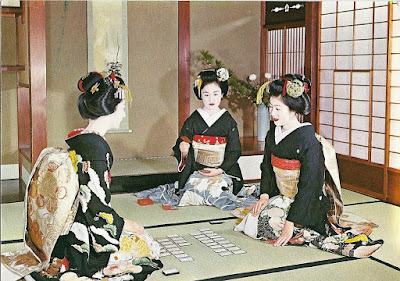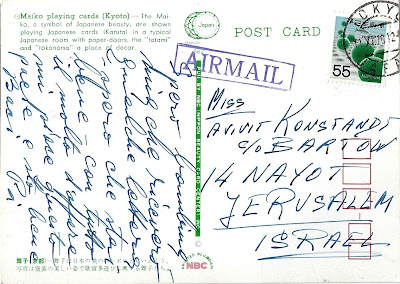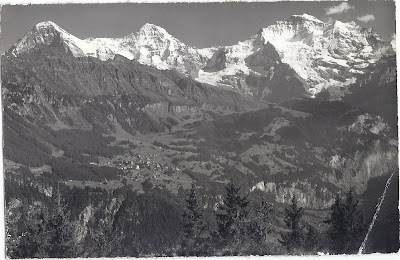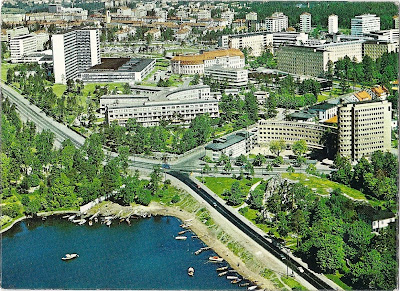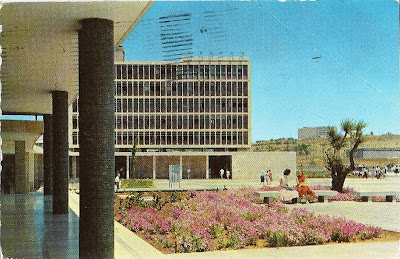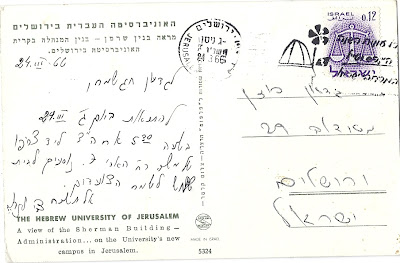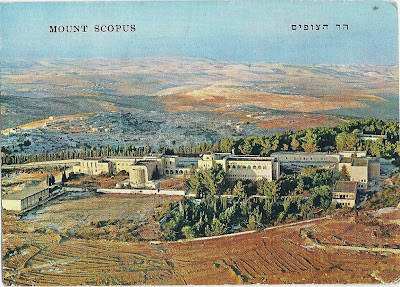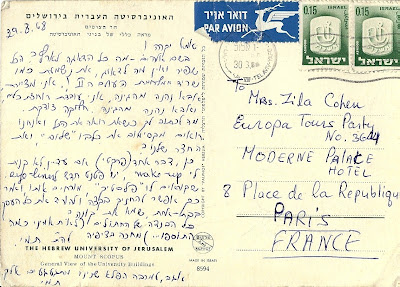I guess I could have started with this lady, since this picture is the indirect cause for the whole blog, but, well, I didn't. She goes with the gentleman from the previous post, at least in my mind, since I found both photos at the same store. And I like her a lot, too; I like her pose, gentle yet mysterious, and I like the dramatic shadow, and I think it's all very beautiful.
אני מניחה שיכלתי לפתוח בתמונה הזו דווקא, כי היא היתה, בעקיפין, הגורם שהביא ליצירת הבלוג, אבל נו, לא כך היה. היא קשורה לאיש מהתמונה הקודמת, לפחות בראש שלי, כי מצאתי את שתי התמונות באותה חנות. ואני מאוד אוהבת גם אותה; אני אוהבת את התנוחה העדינה-אך-מסתורית שלה, ואת הצל הדרמטי, ובכלל, התמונה הזו נורא יפה בעיניי.
But unlike our dapper gentleman, this picture has a little hint of where it came from. The photographer's stamp in the corner. Here it is below, slightly blown up and enhanced - again, only as much as my limited means and skills allow, but in this case, it was enough.
לעומת האדון האלגנטי, עם זאת, בתמונה הזו היה רמז קטן למקום המוצא שלה. חותמת של הצלם, בפינה. הנה היא, להלן, קצת מוגדלת ומשופצת - שוב, רק עד כמה שאני מסוגלת, עם האמצעים והכישורים המוגבלים שלי, אבל במקרה שלפנינו, זה הספיק.
The name "L. Karp" is pretty clear; so are some of the letters of the name below, although some of them have faded quite a bit. But typing the first letters into Google, S-K-I-E-R-N - one of the first autocomplete suggestions on the list was 'Skierniewice' (and once I saw the name, I could read it in the stamp pretty well). It's a town in Poland, about halfway between Warsaw and Lodz.
השם 'L. Karp' די ברור; גם כמה אותיות מהשם שמתחתיו עוד קריאות, למרות שחלקן נמחקו. אבל כשהקלדתי בגוגל את האותיות הראשונות, S-K-I-E-R-N - אחת ההצעות הראשונות ברשימה היתה 'Skierniewice' (וברגע שראיתי את השם, כבר יכלתי לקרוא אותו בחותמת די בקלות). זו עיירה בפולין, בערך במחצית הדרך בין ורשה ולודז'.
Not only that, but with great luck, another photograph taken by Mr. Karp in 1913
made it to the internet, thanks to a Yiddish newspaper that happens to appear in it. The stamp with his name and hometown can be seen pretty well, there, although the style is different. I'm guessing that the picture I have is later, prom the 20s or 30s, since my limited knowledge of art history suggests that the stamp's style is closer to Art Deco. We can imagine Mr. Karp deciding to revamp the logo a little, make it more Modern, something to draw in those sophisticated urbanites who've been to Berlin and seen Bauhaus.
לא זו בלבד, אלא שבמזל גדול, תמונה אחרת שצילם האדון קארפ מסקערניעוויץ (או סקרנביצה, אבל הכתיב היידי חביב בעיניי משום מה) ב-1913
הגיעה גם היא לאינטרנט, בזכות עיתון יידי שמופיע בה. את החותמת, ובה שמו ושם העיר, אפשר לראות שם היטב, אם כי הסגנון שלה שונה. אני מנחשת שהתמונה שאצלי מאוחרת יותר, משנות ה-20 או ה-30, כי מתוך הידע המוגבל למדי שלי בתולדות האמנות נדמה לי שסגנון החותמת שלה קרוב יותר לאר-דקו. אפשר לנחש שמר קארפ החליט לשפץ קצת את הלוגו, שיהיה יותר מודרני. משהו שימשוך את העירוניים המתוחכמים, שכבר היו בברלין וראו באוהאוס.
And then... then came the War.
I tried looking through the Yad VaShem name database, and found, not him exactly (and definitely not the unnamed lady in the picture), but his daughters. Two of them, Khana and Szewa, were also photographers, and appear to have died in the war; the third sister, Varda, filled out '
Pages of
Testimony' for them (
twice,
it appears - I apologise for not including the links, since they do not work for me for some reason, but you can look for yourselves if you want [
Update, June 4 2012: Yad VaShem changed their website a bit, and it seems that now I can link directly to the pages]). She survived, and at least as late as 1999 was living in Tel Aviv. Maybe somebody who knows Varda Gilboa will somehow get here. Maybe she is still alive. Maybe she can tell the story of her father, Lipman Karp, and his photo studio. Maybe she will even recognise this picture.
Maybe not.
The story is out there, somewhere, even if we'll never discover all of it. And I think it's all very beautiful.
ואז... אז היתה המלחמה.
חיפשתי בארכיון יד ושם, ומצאתי לא אותו בדיוק (ובטח שלא את המצולמת האלמונית), אבל את הבנות שלו. שתיים מהן, חנה ושֵׁיבע, עסקו גם הן בצילום, וכנראה שנספו; אחותן ורדה מלאה '
דפי עד' עבורן (
פעמיים,
כנראה; אני מתנצלת שלא צירפתי קישורים, כי משום מה הם לא עובדים לי, אבל אתם יכולים לחפש בעצמכם [
עדכון, 4.6.2012: יד ושם שינו קצת את האתר, ועכשיו אני יכולה לקשר ישירות לדפים]). היא שרדה, ולפחות ב-1999 עדיין חיה בתל אביב. אולי מישהו שמכיר את ורדה גלבוע יגיע לכאן. אולי היא עדיין חיה. אולי היא יכולה לספר על הסטודיו של אבא שלה, ליפמן קארפ. אולי היא אפילו תזהה את התמונה.
ואולי לא.
הסיפור קיים, איפשהו, גם אם לעולם לא נגלה את כולו. וזה נורא יפה בעיניי.
Update (June 4 2012): Not long ago I was looking at the blog statistics and saw that someone got here through searching "varda gilboa" (on Google Uruguay, if it matters). I got a bit curious and tried the search myself, and among a few irrelevant results I ran into
this. Scroll down a bit, she's there. Just one line, though: 'Born in Poland in 1914. Composer. Lived in Israel.' The biographical details fit what we know so far, so I wouldn't be surprised if it the same person. And the detail about her being a composer - this was interesting. So I tried a Hebrew search, to see if I can find what she composed, and came up with two songs, one nearly forgotten, one immensely popular. The first one is a little song called 'Ruach Ruach' ('Wind, O Wind'), which was sung by the marvelous Chava Alberstein when she was very young, in a song festival in 1967 (it was surprisingly hard to find online, but you can hear it in
this recording, starting around the 15-minute mark). The second is 'Happy Birthday'. No, not the one most English-speakers will be thinking about, which was composed by Patty and Mildred Hill; but this Hebrew birthday song is just as popular, over here, and similarly serves as a 'default' birthday song. You can hear a typical example in the video below. This is one of those songs that are so popular that you usually don't even stop to think that they had a composer - but they did, and she was (probably) the daughter of photographer Lipman Karp. What a fasinating story this is turning out to be.
(I was gonna say something like 'Next time you sing Happy Birthday, think of her', but holy crap, why would you do that? That would be depressing. You do not want to think about the Holocaust on someone's birthday. So, yeah, don't do that. But just know she composed it.)
עדכון (4.6.2012): הסתכלתי לא מזמן בסטטיסטיקות של הבלוג וראיתי שמישהו הגיע לכאן בחיפוש של "varda gilboa" (בגוגל אורוגוואי, אם זה משנה). זה סקרן אותי קצת, וניסיתי לחפש בעצמי, ובין כמה תוצאות בלתי-רלוונטיות בעליל נתקלתי גם ב
זה. תגללו קצת למטה ותראו אותה. רק שורה אחת: 'נולדה בפולין ב-1914. מלחינה. חיה בישראל.' הפרטים הביוגרפיים מתאימים למה שידוע לנו עד כה, אז לא יפתיע אותי אם אכן מדובר באותה אישה. והפרט על זה שהיא מלחינה - זה בהחלט נראה לי מעניין. אז ניסיתי לחפש בעברית ולראות אם אני יכולה למצוא מה בדיוק היא הלחינה, ועלו ברשתי שני שירים, אחד עלום למדי ואחד פופולרי מאוד. הראשון הוא שיר בשם 'רוח רוח'; לא זה שאתם חושבים עליו, שכתבה מרים ילן-שטקליס ושרו כל מיני זמרים, ביניהם אריק איינשטיין, אלא אחד אחר, שכתב אוריאל אופק, ושרה חווה אלברשטיין הצעירה מאוד בפסטיבל הזמר והפזמון של 1967 (היה לי קשה להפתיע למצוא את השיר הזה ברשת, אבל אפשר לשמוע אותו
בהקלטה הזו - יחד עם יורם ארבל צעיר אחד, ועוד כל מיני קולות מוכרים יותר ופחות - החל מדקה 15 לערך). השיר השני הוא 'היום יום הולדת'. כן, הזה - השיר שהוא פחות או יותר ברירת המחדל של שירי יום הולדת (הקלטה שלו היה קל בהרבה למצוא, ובחרתי אחת שמדגימה פחות או יותר איך בדרך כלל שומעים אותו), שהוא כל כך פופולרי שבדרך כלל אפילו לא עוצרים לחשוב שמישהו הלחין אותו. אבל הייתה לו מלחינה, והיא הייתה (ככל הנראה) הבת של ליפמן קארפ, הצלם. איזה סיפור מרתק מתגלגל פה.
(עמדתי להוסיף משהו כמו 'בפעם הבאה שאתם שרים "היום יום הולדת" תחשבו עליה', אבל אלוהים אדירים, למה שתעשו דבר כזה? זה ממש מדכא. אתם לא רוצים לחשוב על השואה ביום הולדת של מישהו. אז, כן, אל תעשו את זה. פשוט תדעו שהיא הלחינה את השיר.)
